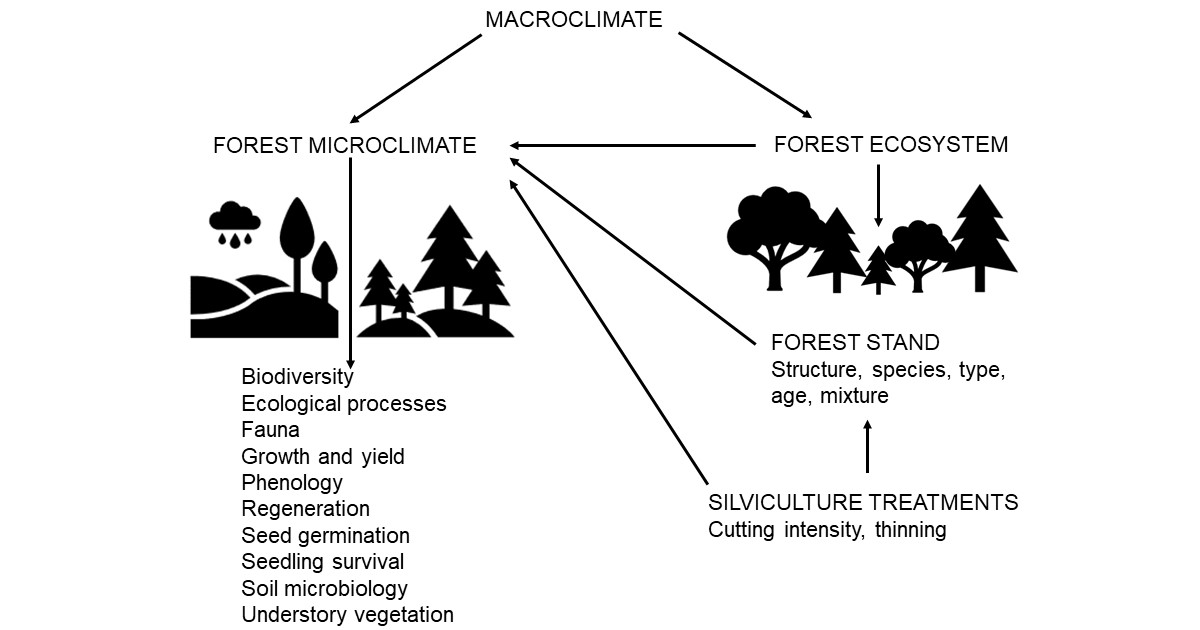Forest Microclimate: Predictions, Drivers and Impacts
A special issue of Forests (ISSN 1999-4907). This special issue belongs to the section "Forest Meteorology and Climate Change".
Deadline for manuscript submissions: 31 March 2025 | Viewed by 5200

Image courtesy of Damir Ugarković
Special Issue Editors
Interests: forest ecology; forest climate interaction; bioclimatology; microclimate
Special Issues, Collections and Topics in MDPI journals
Interests: forest ecology; forest hydrology; microclimate; climate change; soil and water conservation; sustainability
Special Issues, Collections and Topics in MDPI journals
Special Issue Information
Dear Colleagues,
Forest vegetation creates a special forest climate or microclimate. The microclimate of the forest stand is influenced by the macroclimate of the wider area, the type of forest habitat, topography, forest trees species, and the age and structure of the forest stand. Microclimate conditions have an important role in forest ecosystem processes. Ecological processes, such as photosynthesis, evapotranspiration, respiration, the decomposition of matter, the nutrient cycle, and others, are related to the microclimatic conditions. The forest microclimate is crucial for seed germination, the growth and survival of tree seedlings and understory vegetation, the growth and reproduction of plants, soil microbiology, biodiversity, and fauna. We can also change the microclimate conditions using silviculture treatments, i.e., cutting down forest trees and thinning the stand. Likewise, the degradation of forest stands worsens their microclimatic conditions. Urban trees and forests have a specific microclimate to mitigate climatic extremes in cities and provide citizens with favourable conditions for rest and recreation. To study all the biological and ecological processes in forests, we need accurate climate data, which is why knowledge about the forest climate or microclimate is important.
Potential topics include, but are not limited to:
- Forest–microclimate interactions;
- Forest microclimate and natural regeneration;
- Silviculture treatments and forest climate;
- Large-scale forest disturbances and microclimate;
- Forest microclimate and soil microbiology;
- Forest phenology;
- Forest degradation;
- Canopy gaps;
- Climate change and forest climate change;
- Urban forests and park forests;
- Forest microclimate and wildlife.
Dr. Damir Ugarković
Dr. Urša Vilhar
Guest Editors
Manuscript Submission Information
Manuscripts should be submitted online at www.mdpi.com by registering and logging in to this website. Once you are registered, click here to go to the submission form. Manuscripts can be submitted until the deadline. All submissions that pass pre-check are peer-reviewed. Accepted papers will be published continuously in the journal (as soon as accepted) and will be listed together on the special issue website. Research articles, review articles as well as short communications are invited. For planned papers, a title and short abstract (about 100 words) can be sent to the Editorial Office for announcement on this website.
Submitted manuscripts should not have been published previously, nor be under consideration for publication elsewhere (except conference proceedings papers). All manuscripts are thoroughly refereed through a single-blind peer-review process. A guide for authors and other relevant information for submission of manuscripts is available on the Instructions for Authors page. Forests is an international peer-reviewed open access monthly journal published by MDPI.
Please visit the Instructions for Authors page before submitting a manuscript. The Article Processing Charge (APC) for publication in this open access journal is 2600 CHF (Swiss Francs). Submitted papers should be well formatted and use good English. Authors may use MDPI's English editing service prior to publication or during author revisions.
Keywords
- forest microclimate
- stand structure
- forest cover
- ecosystem processes
- species composition
- silviculture
- degradation stages
- biodiversity
- microbiology
- urban forests
Benefits of Publishing in a Special Issue
- Ease of navigation: Grouping papers by topic helps scholars navigate broad scope journals more efficiently.
- Greater discoverability: Special Issues support the reach and impact of scientific research. Articles in Special Issues are more discoverable and cited more frequently.
- Expansion of research network: Special Issues facilitate connections among authors, fostering scientific collaborations.
- External promotion: Articles in Special Issues are often promoted through the journal's social media, increasing their visibility.
- e-Book format: Special Issues with more than 10 articles can be published as dedicated e-books, ensuring wide and rapid dissemination.
Further information on MDPI's Special Issue polices can be found here.





